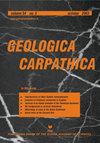圣十字山脉(波兰)上温洛克页岩(志留纪)中的斜长石周转和δ13Org漂移
IF 1.5
4区 地球科学
Q4 GEOSCIENCES, MULTIDISCIPLINARY
引用次数: 2
摘要
志留纪的中晚期荷马时代是生物群、海洋化学和海平面剧烈变化的时期,被称为lundgreni灭绝(笔石灭绝)、Mulde生物事件(牙形石翻转事件)或荷马碳同位素偏移(CIE),可能与冰川影响的气候微动有关。本文通过对Prągowiec峡谷剖面的分析,给出了Małopolska地块北缘Kielce地区(波兰圣十字山)深水沉积和笔石序列的新信息。该区已发现朗格里尼-尼尔松尼笔石生物带。该层段由暗色页岩组成,底栖动物非常罕见,表明其为深开海(远洋)古环境。从lundgreni(2个样本)、parvus(2个样本)、praedeubeli(2个样本)、praedeubeli - deubeli(1个样本)、ludensis(2个样本)和nilssoni(1个样本)生物带中采集10个样本进行δ13Corg分析。根据δ13Corg结果,可以很好地识别Mulde生物事件的第一次δ13Corg正偏移。δ13Corg值从- 30.7‰~ - 30.1‰上升到- 29.3‰~ - 28.7‰,而在前-小野间则降至- 30‰以下。Prągowiec沟未发现穆德事件的第二个正δ 13g峰。基于笔石物种共出现的Raup-Crick度量的数值比较,在给定的地点,上荷马阶的这些分类群具有显著的生物带间更替的特征。本文章由计算机程序翻译,如有差异,请以英文原文为准。
Graptolite turnover and δ13Corg excursion in the upper Wenlock shales (Silurian) of the Holy Cross Mountains (Poland)
Abstract The mid–late Homerian Age of the Silurian Period was a time of intense changes in biota, oceanic chemistry, and sea level and is known as the lundgreni extinction (for the graptolite extinctions), the Mulde bioevent (for the conodont turnover event) or the Homerian carbon isotope excursion (CIE) probably related to glacially influenced climate perturbation. New information on this interval from the deep water sedimentary and graptolite succession of the Kielce Region (Holy Cross Mountains, Poland) of the northern margin of the Małopolska Block is presented here based on analysis of the Prągowiec Ravine section. The lundgreni–nilssoni graptolite biozones interval have been recognized there. This interval is composed by dark shales with very rare benthic fauna, which indicate the deep open-marine (pelagic) paleoenvironment. Ten samples were taken for the δ13Corg analysis from the lundgreni (2 samples), parvus (2 samples), praedeubeli (2 samples), praedeubeli–deubeli (1 sample), ludensis (2 samples) and nilssoni (1 sample) biozones. According to the δ13Corg results, the first positive δ13Corg excursion of the Mulde Bioevent is well recognized. The δ13Corg values rise from −30.7 – −30.1 ‰ in the lundgreni Biozone to −29.3 – −28.7 ‰ in the parvus Biozone and fall below −30 ‰ in the praedeubeli–deubeli interval. The second positive δ13Corg peak of the Mulde Event was not recognized in the Prągowiec Ravine. Based on the numerical comparisons using Raup-Crick metric of co-occurrences of graptolite species, the upper Homerian was characterized by significant between-biozone turnover of these taxa at the given locality.
求助全文
通过发布文献求助,成功后即可免费获取论文全文。
去求助
来源期刊

Geologica Carpathica
地学-地球科学综合
CiteScore
2.40
自引率
23.10%
发文量
26
审稿时长
>12 weeks
期刊介绍:
GEOLOGICA CARPATHICA covers a wide spectrum of geological disciplines including geodynamics, tectonics and structural geology, volcanology, stratigraphy, geochronology and isotopic geology, karstology, geochemistry, mineralogy, petrology, lithology and sedimentology, paleogeography, paleoecology, paleobiology and paleontology, paleomagnetism, magnetostratigraphy and other branches of applied geophysics, economic and environmental geology, experimental and theoretical geoscientific studies. Geologica Carpathica , with its 60 year old tradition, presents high-quality research papers devoted to all aspects not only of the Alpine-Carpathian-Balkanian geoscience but also with adjacent regions originated from the Mediterranean Tethys and its continental foreland. Geologica Carpathica is an Official Journal of the Carpathian-Balkan Geological Association.
 求助内容:
求助内容: 应助结果提醒方式:
应助结果提醒方式:


